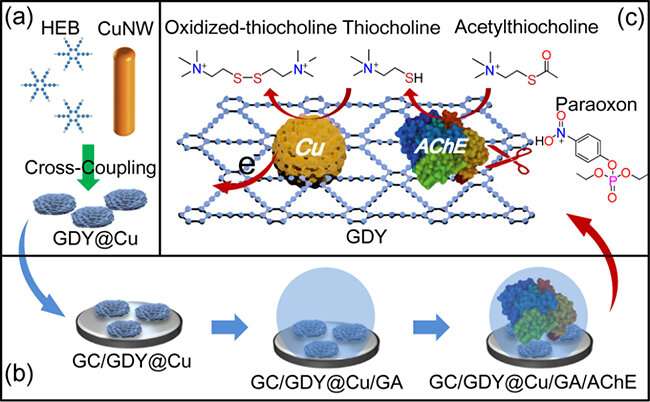Electrochemical biosensor for interference-free detection of organophosphorus pesticides

Organophosphorus pesticides (OPs), a class of lethal nerve agents widely used in agriculture, pose an extreme threat to human health and the environment.
An electrochemical biosensor based on the inhibition of acetylcholinesterase (AChE) has been regarded as an ideal tool for rapid detection of OPs, but it is suffered from the sluggish electrode kinetics and high oxidation potential toward signal species.
Recently, a research group led by Prof. Lu Xianbo and Prof. Chen Jiping from the Dalian Institute of Chemical Physics (DICP) of the Chinese Academy of Sciences (CAS) has developed a high-performance electrochemical biosensor for the interference-free detection of OPs.
This study was published in Biosensors and Bioelectronics on Feb. 21.
The researchers synthesized a nanocomposite of ultrafine Cu quantum dots (QD) uniformly loaded on three-dimensional ultrathin graphdiyne (GDY) nanosheets (denoted as Cu@GDY) via a one-step strategy. Cu@GDY showed a high density of active sites with persistent stability.
Then, they fabricated an AChE biosensor based on Cu@GDY to detect OPs and found that the results of the Cu@GDY nanocomposite could amplify the electrochemical signal and reduce the oxidation potential for OPs.
Moreover, they investigated the potential electro-catalysis mechanism and structure-activity relationships of the proposed biosensor through characterizing the kinetics of electrode reaction, the source of active sites, and the interaction between signal species and active site. "After theoretical derivation and experimental verification of enzyme inhibition kinetics, the biosensor was verified to have high sensitivity to detect OPs," said Prof. Lu.
More information: Kai Niu et al, Ultrathin graphdiyne nanosheets confining Cu quantum dots as robust electrocatalyst for biosensing featuring remarkably enhanced activity and stability, Biosensors and Bioelectronics (2022). DOI: 10.1016/j.bios.2022.114111
Journal information: Biosensors and Bioelectronics
Provided by Chinese Academy of Sciences





















